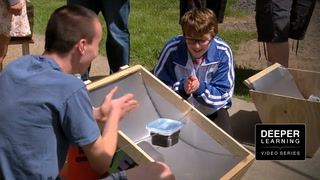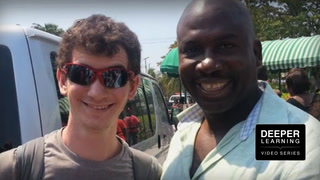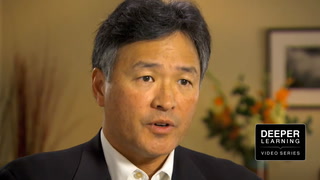The Building Blocks of Project-Based Learning Transcript
+++ 00:00:02 +++
Card:
Deeper Learning Elevating Student Thinking and Student Voice
Card:
Deeper Learning Competencies
•Master core academic content
•Think critically and solve complex problems
•Work collaboratively
•Communicate effectively
•Learn how to learn
•Develop academic mindsets
+++ 00:00:31 +++
Hunter: Project-based learning is teaching us how to really be ready for the 21st Century workforce.
Lana Hower: All right, Hunter, it's all you.
Hunter: Maybe we can have a workshop on that.
Lana Hower: It makes them want to learn.
Tom Morrill: You all have topics, you're all in teams, and now it's a matter of researching your topic.
Paul Curtis: The trick is that throughout the process, you're checking and monitoring their progress.
Student: We're working on the loss of aquatic biodiversity.
Ben: We are looking for a solution to overpopulation.
Ben: Project-based learning, it's definitely different.
Lana Hower: They learn deeper, they understand more.
+++ 00:00:59 +++
Paul Curtis: Just because it's always been done a certain way doesn't mean it always has to be done a certain way.
Jason Irwin: You need to have your starting temperature of the water. And then let it sit for 15 minutes.
Patti: Twenty-two Celsius.
Student: That's good enough for me.
Patti: Awesome!
Card:
The Building Blocks of Project Based Learning
featured organization: New Tech Network
+++ 00:01:25 +++
Paul Curtis: Project-based learning really begins with the teachers, understanding what it is they're supposed to cover in their classroom and finding real-world applications for that content.
Leah Penniman: Because you need to understand cause, effect, problem, solution, case study.
Lower Third:
Paul Curtis
Director for School Quality
New Tech Network
Paul Curtis: Rather than thinking day-by-day, teachers think of units that maybe last three weeks, and they're thinking about what's the over-arching theme that pulls this content together and maybe makes it relevant to other classrooms and things that are happening out in the community?
+++ 00:01:52 +++
Tom Morrill: What could be a cause for environmental racism, and what are the effects of it. Excellent!
Paul Curtis: After the planning process, the project begins for the students with a major launch.
Card:
Project Rollout
"This TVHS Life"
12th Grade English
Lana Hower: Today, like I told you guys, we're rolling out our new project, it's "This TVHS Life" project. Some of you have said you listened to "This American Life." We're starting with the entry document, and the group rubric.
Lower Third:
Lana Hower
English Teacher
Tech Valley High School
Lana Hower: Project's "This American Life" based. So they had to model a podcast after "This American Life," based on Tech Valley, writing short stories.
Lana Hower: All right, Hunter, it's all you.
+++ 00:02:26 +++
Hunter: All right, guys, what do we know about this? "This TVHS Life" project? Ashley.
Ashley: We're creating a podcast.
Lana Hower: It's not my show, it's their show. It's their class, it's our space, I'm facilitating, they're learning, but it's really their learning, not mine. So I handed it over to them to facilitate, so they could be more involved in it.
Elizabeth: Your tone of voice is controlled and confident, and it doesn't sound like you're just reading off a piece of paper.
Lana Hower: They take more interest in the work that comes before, the scaffolding work that comes before it, so they need to know it, because they want to do a good job on their final short story, because they want to do something really meaningful to themselves, so it makes them want to learn.
+++ 00:03:02 +++
Student: So we have to properly cite at the end of our podcast.
Hunter: If you're going to use music, please use free-use and don't steal.
Lower Third:
Hunter
12th Grade Student
Tech Valley High School
Hunter: Something that Tech Valley holds very dearly is teaching us how to be leaders. And in working with groups, how to facilitate small groups of people, large groups of people, how to really be ready for the 21st Century workforce.
Hunter: Let's move on to "Need to knows."
Student: How do we provoke further thought? How do we make people think more.
Hunter: Jessie Ray [ph?]?
Jessie: How do we create a theme with three to four different stories?
Elizabeth: Will group text affect the length requirements for our podcast?
Lower Third:
Elizabeth
12th Grade Student
Tech Valley High School
+++ 00:03:35 +++
Elizabeth: The project rubric, as well as the entry document, are the most crucial things to a project roll-out, because that's when you're getting to be introduced to the project, and you really get a feel for what's going on.
Student: What themes do you guys think that we could use for the project?
Elizabeth: Things we probably shouldn't have gotten away with.
Jessie: First time at TVHS.
Student: Josie? [ph?]
Josie: Hallway experiences. Some stuff goes down in the hallway.
+++ 00:04:02 +++
Lana Hower: I have to start with the standards, so I start with the standards, I craft the project, I come up with the ideas, I try to-- for the seniors, I try to make it as open as possible.
Student: I feel like if we want, we can get really wacky with it.
Student: Yeah.
Student: Like what if, instead of a school, it was some sort of secret agent training camp, or something. I don't know.
Paul Curtis: Common core's really opened the door for us. It has allowed people to say there might be a different way, a different set of standards that we're going to look at for measuring students besides standardized tests that focus on memorization of facts and figures.
Jessie: Do we need a pacing chart?
Student: No, let's not.
Student: Ideas?
Jessie: It could be like a-- yeah, let's do an ideas page.
Student: Yeah.
Student: Yeah.
+++ 00:04:38 +++
Student: We needed to have like one about something that like really impacted us. And we need one about just like the project in general. Like something about we just seen the primaries. Like that was so powerful.
Hunter: So day off, the people--
Hunter: The curriculum's the same, but the way it's taught is very, very different, project-based learning. We're graded on all sorts of things. Not only content, but information literacy, content literacy, self-direction, communication, a slew of learning outcomes to really make sure that we're not only learning how to know knowledge, but how to learn and how to work in a team with other people.
+++ 00:05:17 +++
Hunter: We have to be careful.
Student: Yeah, because some things we can't talk about.
Student: We'll be fine!
Lana Hower: They learn deeper, they understand more, they understand complex ideas. They've taken ownership of that learning, and they've been a leader in that learning, so now it's theirs.
Student: We can add it to the best projects of the year.
Card:
Project Mid Review
"Change The World"
9th Grade
Environmental Science
+++ 00:05:40 +++
Paul Curtis: After the launch, the kids are usually put into teams. The students start to do explorations. They do web research. The teachers may provide workshops or lectures. The trick is that throughout the process, you're checking and monitoring their progress. Teacher will build in opportunities for benchmarking and formative assessment to make sure the kids aren't going off-track.
Tom Morrill: We're going to start out with some teamwork time. The very first thing is choosing deadlines for all the benchmarks in the project, and putting those on your pacing chart.
+++ 00:06:12 +++
Leah Penniman: This project is titled, "We Can Change the World." And the students are challenged to choose a current problem that has both a social and environmental dimension.
Tom Morrill: So you all have topics, you're all in teams. And now it's a matter of researching your topic.
Leah Penniman: Mr. Morrill and I will each be working with half of the teams, and we'll help you identify reliable, vetted sources to use for your research.
Lower Third:
Tom Morrill
Social Studies Teacher
Tech Valley High School
Tom Morrill: Leah and I co-teach. I'm the social studies part of the brain, and Leah's the science part of the brain. And actually, the reality is we both know these subjects pretty well.
+++ 00:06:43 +++
Tom Morrill: You have to create your own "Need to Knows" from this rubric, from the rubric ___________.
Lower Third:
Leah Penniman
Environmental Science / Biology Teacher
Tech Valley High School
Leah Penniman: I don't think you can do project-based learning without formative assessment. And at its most basic level, what that means is giving students timely feedback before they're finished.
Student: Our topic is "War that has Effect on the Environment."
Student: We're working on the loss of aquatic biodiversity.
Ben: We are looking for a solution to overpopulation.
+++ 00:07:08 +++
Ben: Project-based learning? It's definitely different. You kind of realize like as you go that you are getting information out of it; it's just a different way of getting the information. Because you're not directly being given. Like here's a textbook, "Read like this chapter, and then we'll talk about it in class tomorrow." You're searching for it on your own, and then applying it in ways that make sense in real life.
Student: We should only highlight the ones that we can have, need to know, and knows .
Student: All right.
+++ 00:07:33 +++
Leah Penniman: They're about a third of the way through the project. We gave them the chunks of the project, which we call benchmarks, but there were no deadlines. So their job as a team is to figure out what are reasonable deadlines for each of these sub-pieces? But we're really teaching and walking through, how do you schedule out your time effectively?
Student: Like doing those at the same time, like some people working on like, I don't know, writing a letter, or whatever we end up doing. And other people work at another station.
Student: I could do that.
Ben: We can probably do that.
Student: Okay.
Student: solution, it should be due like the 26th, maybe?
+++ 00:08:03 +++
Paul Curtis: They are asked to work on contracts, to understand how they're going to work with each other, to really understand and hold each other accountable to the group process.
Student: The contract kind of helps in many ways, like it keeps everybody on track, and if you like break the contract, you get warnings.
Student: There's three warnings. And you could get a warning for, say, you didn't get your work done on time. You can get a warning. And by the third warning you would get fired, and you would have to do the project alone. Because that's kind of how it happens in the real world. You'd get fired, and you'd be on your own.
+++ 00:08:36 +++
Student: The presentation's on the 31st.
Tom Morrill: With the formative assessment techniques, we scaffold them through whether it's content or skills, phase by phase in the project.
Tom Morrill: What are some kinds of mutations that are done?
Student: So it's like what he's looking up, an example.
Tom Morrill: Excellent, okay.
Leah Penniman: Look up another source, because this tells you about its existence, but not its impacts.
Student: Okay.
Leah Penniman: And impact is really important.
Student: Do we have the definition of crowd sourcing?
+++ 00:09:06 +++
Student: It's in the presentation.
Student: All right, try taking a look at some Wikipedia entries on the Boston Tea Party.
Tom Morrill: We are blowing the social studies scores out of the water, the averages. So we're doing very well on that measure. I think the other way we really know we're doing well is when we see our students.
Tom Morrill: Here you're going to choose one historical example.
+++ 00:09:27 +++
Tom Morrill: Getting them to engage their minds to solve the problem, not just taking direction from the teacher, in that way it's really student-centered. And so that's the beginnings of them starting to take ownership of their own learning, and becoming a self-directed learner.
Student: ___________ absurd figure of 296 billion people in 150 years.
Ben: That's too many people.
Student: Too many people.
Paul Curtis: The students are engaged, they have a sense of community, and they're learning those critical skills that will allow them to be successful in the workplace and in college.
Card:
Project Debrief
"Solar Cooker"
10th Grade Algebra
+++ 00:10:04 +++
Paul Curtis: The project usually ends up with some sort of big presentation. Some opportunity for the students to show what they know.
Jason Irwin: Okay, class, Ms. Sweeny and I are going to facilitate a final project reflection.
Lower Third:
Jason Irwin
Math Teacher
Tech Valley High School
Jason Irwin: Today, we did a student reflection on the previous project that we just ended, was a solar collector, in which they design and build a parabolic trough to reflect sunlight, to a place they wanted it to go, to heat up something.
+++ 00:10:29 +++
Student: I like how we got to actually build a solar collector, and that we're going to be able to test them, instead of just theorizing how to make one.
Student: I really liked how we had to like basically create all the dimension and everything, and make-- do all the math to like get the shape right, and--
Lower Third:
Andrew
10th Grade Student
Tech Valley High School
Andrew: We were assigned to design solar ovens for towns in rural Haiti. We had to plot coordinates on the wood, cut it out, build it.
+++ 00:10:56 +++
Student: We had to really keep up with what everyone's doing, and what everyone has done so that we can hold them accountable the second they don't do their work.
Jason Irwin: To have them reflect on the project itself, and how it went from their perspective helps us as teachers to plan it next year, or plan another-- the next project for them.
Student: I feel like the teacher should assign team roles, so different students could get out of their comfort zone more and learn more skills.
+++ 00:11:24 +++
Michelle Sweeny: Thank you all for your very thoughtful feedback and reflection, we always use it to rethink our projects and what we do in the classrooms.
Jason Irwin: We have some bottles of water and some thermometers, and let's go outside and test your designs.
Andrew: Don't touch, don't touch.
Patti: Nice and clear in the sun.
Jason Irwin: You need to have your starting temperature of the water and then let it sit for 15 minutes. And then a temperature after minutes of the water.
Patti: Twenty-two Celsius.
Student: Okay.
Lower Third:
Patti
10th Grade Student
Tech Valley High School
+++ 00:12:00 +++
Patti: The amount of math that does go into it is actually quite surprising. Coming up with the equations and formulas that we would have to use in order to implement in this project. It allows us to put a why into it. Like why are we even learning this?
Student: Now we wait.
Patti: Now we wait!
Jason Irwin: I really like the height. I really do.
Michelle Sweeny: Yeah, I do, too.
Jason Irwin: It's very convenient to use. I think you guys took a-- one of you took that into consideration. I feel like I could barbecue something.
+++ 00:12:30 +++
Jason Irwin: Did you take that into consideration, they may be blocking some of the reflective surface with the tray?
Student: We decided if we used like the reflective material, since it's metal, it would hit up more. And it hits under it, it heats it up.
Jason Irwin: Okay.
Lower Third:
Michelle Sweeny
Algebra Teacher
Tech Valley High School
Michelle Sweeny: They believed the science that they had studied, and they believed the math that they had studied. But until they actually took it outside and recorded the temperature and saw what happened, I feel like just kind of put the nail in, you know, their belief of this actually works.
+++ 00:13:01 +++
Michelle Sweeny: Okay, ready? Take the temperature.
Patti: Okay, ready? Take the temperature.
Student: Twenty-right, right?
Patti: Yeah.
Student: Did it go up?
Patti: It went up two degrees Celsius.
Student: High-five, that's good enough for me!
Patti: And that's with the angle being changed constantly. That's awesome!
Student: That is good enough for me. I'm fine with it.
+++ 00:13:15 +++
Paul Curtis: You can engage them in critical thinking, you can ask them to do presentations, you can ask them to do rigorous work collaboratively. There are practices that will allow you to be successful with that. Just because it's always been done a certain way doesn't mean it always has to be done a certain way. This work is possible to really engage and empower these students to become impactful people on society and in the workforce.
Patti: Victory dance!
#### End of New_Tech####














4 Comments
patrick ryan Jul 25, 2017 9:50am
Jason Skrzat Mar 15, 2016 1:37pm
perihan magdi Apr 25, 2014 11:23am
Noel Arvizu Mar 25, 2014 1:36pm